#085: Schizophyllum commune, The Mushroom with Over 28,000 Sexes
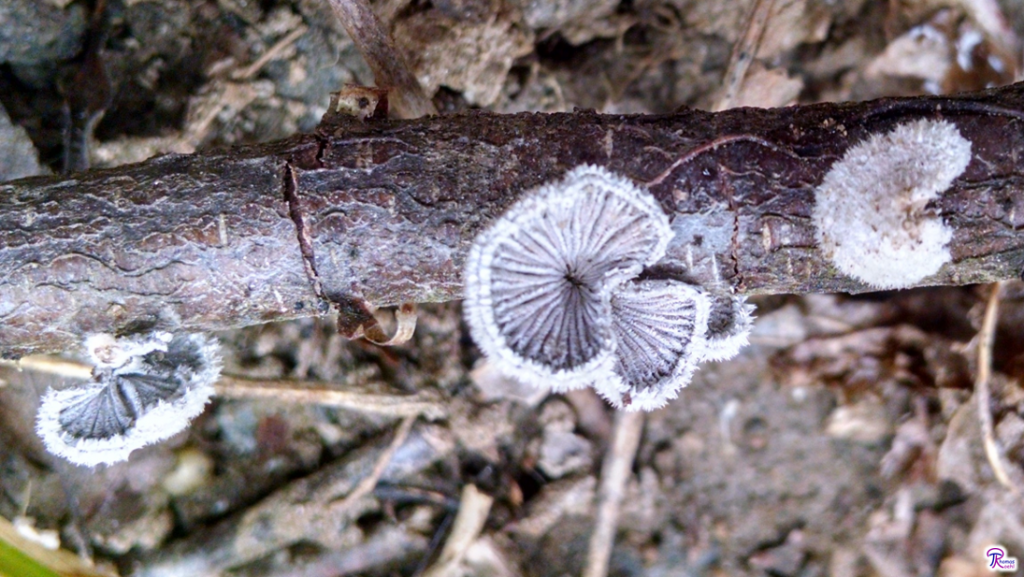
If you think dating is complicated in the human world, be glad you’re not Schizophyllum commune. Humans have two basic biological sexes and six or more gender identities to deal with, but S. commune has to choose from over 28,000 different sexes! This overly complex system is based on genetics and the weird way fungi reproduce. But this isn’t just a weird example, it’s also one of the most common mushrooms in the world. You can probably find the mushroom out now, and identify it easily. The little white mushroom is easily distinguished by its small gills, which appear to be split lengthwise. This unique feature has led to its common name, the “Split Gill” or sometimes “Common Split Gill.”1,2
Description
Personally, I think Schizophyllum commune is one of the most beautiful fungi. I’m not really sure what it is that fascinates me about it, but I always enjoy finding this mushroom. The Split Gill looks very boring from above. Its irregularly lobed pileus is small (1-5cm across), whitish, and hairy. S. commune grows outward from a central point, so its shape can change depending on how it is positioned relative to its substrate. Consequently, it can be fan-shaped with no stipe on the side of a log to disc shaped with a short stipe when on top of a log.2–5
The Split Gill makes up for its boring upper surface with its truly unique lower surface. Its underside is hairy, whitish (with tints of grey, pink, or tan), and features rudimentary gills. If you look closely, you will notice that its gills, which are little more than folds, each have one slit that runs straight down the middle of the gill.2–5 This feature is not found in any other genus of mushrooms and has resulted in S. commune’s common and scientific names (Schizophyllum = “split leaf”).1 Because of this split, these are not true gills but rather paired “cupules.”3
These split gills are actually a method to withstand periods of dry weather. The fertile surface of the mushroom is found on the inner surface of each gill slit. When moisture is plentiful, the slits open up to allow spores to drop to the ground. The spores are white and the fungus will produce a white spore print. During dry periods, the mushroom shrivels up and becomes tough or leathery, causing the slits to fold closed. This protects the spore surface and allows the mushroom to last a long time and quickly resume spore production in good weather. Even last year’s fruiting bodies will produce spores when the weather is favorable.2–5
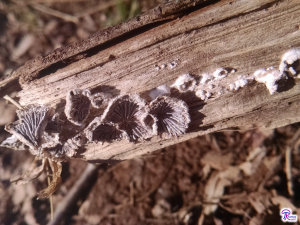
Ecology
S. commune is a common and globally distributed species that grows on every continent except Antarctica (thus the species name commune, meaning “common”).2,3,5 Very few mushrooms actually have a worldwide distribution, and the Split Gill is one of them.2,5 Intensive studies carried out by John Raper and other researchers from Harvard in the 1950’s to 70’s proved this and helped the Split Gill become a model organism for studying mushrooms. These scientists painstakingly collected and grew S. commune samples from all over the world, testing them to see which ones could successfully mate with one another. Thanks to these efforts, we know that S. commune represents a single global species and know all the possible mating types for the fungus (more on those later).1,5
The Split Gill is a decomposer of hardwoods and other plant matter (including bales of hay).2–5 It causes a white rot in wood, meaning that it decomposes lignin and leaves the cellulose.5 However, this enterprising little fungus has also been known to cause disease in humans on occasion, usually in immunocompromised individuals. One recorded instance saw the fungus produce mushrooms inside a child’s nose.1,6
Thanks to S. commune’s ability to dry out and rehydrate, you can find the mushroom at any time of year.2–5 I tend to find the youngest fruitbodies in spring and summer, though they prefer fall in California.4
Reproduction with 28,000 Sexes
One of the most interesting things about S. commune is its system of sexual reproduction. It is basically the same as that of most fungi, but the Split Gill has acquired some genetic changes that give it a total of over 28,000 distinct sexes. Fungal sex tends to be difficult to understand, but it’s not that hard if you forget almost everything you’ve learned about sexual reproduction in animals and plants. That being said, I have included some comparisons to the other eukaryotes in an attempt to make this topic a little easier to comprehend.
In order to understand fungal sexual reproduction, you need to understand the fungal nuclear cycle (how the cell nucleus changes over the course of a fungus’ life). The fungal nuclear cycle has four stages: gamete, monokaryon, dikaryon, and meiosis. In the gamete stage, the fungus consists of a single spore. This spore is the product of meiosis, so it has one of each chromosome and one of each possible gene. Any cell with only one copy of each chromosome is called a “haploid” cell and is designated by the letter n. The spore stage is somewhat equivalent to a sperm/egg in plants and animals.1
In suitable conditions, the spore germinates and grows. This is the monokaryon stage (“karyon” refers to the nucleus, so “monokaryon” means “one nucleus”). No new genetic material has been added, so each fungal cell still contains one nucleus and each nucleus is identical and has exactly one of each chromosome (haploid, n). This stage lasts a long time and represents a significant part of the fungus’ life span. During this time, the fungus can grow and produce asexual spores (which will produce new fungi in the monokaryon stage).1
When the fungus meets a suitable mate, the two fungi will fuse their cells and enter the dikaryon stage (for more on this process – called anastomosis – see FFF#128). In this stage, each fungal cell has two nuclei – one with chromosomes from one parent and one with chromosomes from the other parent – that remain separate (dikaryotic, n+n). This stage can also last a long time and the fungus can still grow and produce asexual spores that can germinate to form new fungi in the dikaryon stage.1
The final stage – meiosis – takes place in only a few select fungal cells. Only during meiosis do the nuclei fuse with one another to create a “diploid” (2n) cell that contains a single nucleus with two pairs of each chromosome. This cell then splits apart into sexual spores (gametes), which each contain one haploid nucleus (n).1
To recap: gamete (n) –> monokaryon (n) –> dikaryon (n+n) –> meiosis (2n) –> gamete (n)1
Sexual compatibility in fungi is controlled by genes called “mating types.” In the simplest possible situation, there is one mating type gene with two possible variations (known as “alleles”). Mycologists designate these mating types “A1” and “A2.” Two haploid fungi can fuse to form a dikaryon only if their mating type alleles are different. This system is roughly equivalent to sex in animals, except that there are usually no morphological differences between fungi with different mating types. Human men can successfully have children with only women, and A1 fungi can successfully mate with only A2 fungi. Thus, there are two “sexes” in this system. When this fungus produces spores, half of the spores will have the mating type A1 and the other half will have A2. In this system, an individual will be able to mate with half of the population and with half of its siblings.1,7
Mating with your siblings is not good, even in the fungal world. If an organism does mate with its siblings, detrimental recessive genes may be expressed and detrimental mutations will accumulate. Outcrossing (mating with an individual from a different family) provides a greater chance that harmful mutations will stay silent. A simple way to improve the chances of outcrossing is to add another mating type allele, say “A3.” In this case, an A1A2 fungus will still produce A1 and A2 spores that will be able to mate with half of their siblings. However, other fungi nearby will produce A1, A2, and A3 spores in roughly equal amounts. When you consider the population of spores, 33% will be A1, 33% will be A2, and 33% will be A3. Consequently, an A1 spore has a 33% chance of encountering an incompatible A1 spore but a 67% chance of encountering a compatible A2 or A3 spore. In other words, it is compatible with 50% of its siblings but 67% of the fungi at large, meaning it will be easier to find a compatible fungus in the population at large than in your own family. You can add more alleles to improve the odds further, but any given spore will still be compatible with 50% of its siblings.1,7
You can reduce the percentage of compatible siblings by adding another mating type gene, say “B.” If there are two mating types with two possible alleles each (so your options are: A1, A2, B1, and B2), then every dikaryotic fungus will have one copy of each mating type gene. They can either be arranged A1B1xA2B2 or A1B2xA2B1. The A and B genes are located on different chromosomes, so they will be distributed randomly to the spores. Possible spore genotypes are: A1B1, A1B2, A2B1, and A2B2. Fungi using this system can mate successfully only if both of their mating type genes are different. For example, the A2B2 spore can mate only with an A1B1 fungus. Since each of the spore genotypes is equally likely, any given spore will be able to mate with only 25% of its siblings. This is a great improvement over the system with one mating type gene.1,7
Of course, in this simple system the spore is compatible with only 25% of the population at large and has the same chance of mating with its siblings as it does with a different fungus. To improve the odds of outcrossing, you can add more alleles, such as A3 and B3. Now, any given spore is compatible with 25% of its siblings and 44% of the population, making it a lot easier to find a mate in the population at large. To increase the odds of outcrossing even further, just add more alleles!
Fungi have developed a great many variations on the systems described above. Some of these strategies allow the fungus to mate with itself (which ensures the fungus’ offspring can produce sexual spores), while others improve the chances of outcrossing.7 I will eventually get around to explaining how some of these other systems work, but for now let’s focus on S. commune. The Split Gill’s genetics are designed to encourage as much outcrossing as possible. Not only does it use two different mating type genes, but it has many alleles for each gene: over 300 for the A gene and over 90 for the B gene. This means the Split Gill has over 28,000 possible sexes (distinct combinations of the A and B genes). Any given spore will still be able to mate with 25% of its siblings, but it will also be able to mate with 99.98% of the population. These odds greatly favor outcrossing, which supports genetic variation in the species.1
Did you understand that? If so, wonderful! If not, don’t worry too much. Although the outcrossing explanation is the most common one for S. commune’s extreme mating type diversity, it isn’t the only one. In fact, some mycologists dispute whether this actually works. Simply tallying up the number of mating types from around the world doesn’t necessarily give you an accurate estimate for outcrossing. For one thing, certain mating type alleles will be more common in certain areas. If an A1B1 spore happens to be in an area where 70% of the spores have an A1 allele and 50% of the spores have a B1 allele, it could mate with only 15% of the spores, but would still be able to mate with 25% of its siblings. Complications like that make it hard to assess how effective S. commune is at outcrossing.
There are alternative theories to explain the high diversity of mating type alleles in S. commune. Unfortunately, I can’t find them online or in my notes. I’m sure I made a note of one of these, but I just can’t remember when that was.
Could this mating type system account for the great success of this global species? It probably has some role. The Split Gill (which is already one of the most thoroughly-studied mushrooms) and its relatives certainly deserve to be researched further. Their ecology and genetics present a unique opportunity to learn more about what makes mushrooms successful.
Similar Species
Thanks to their split gills, there isn’t anything else in North America that you are likely to confuse with S. commune. There are a few other species in the genus Schizophyllum, but they are rarely encountered and have much smaller ranges than that of S. commune.5
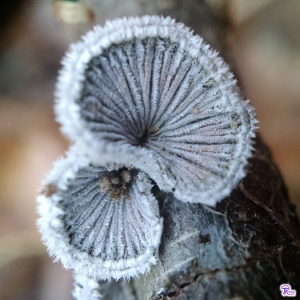
Edibility
Everyone I know considers this mushroom inedible, and it’s easy to see why: the mushrooms are small, thin, and usually dry – there’s just not much to eat.3–5 However, they are used as food and used medicinally in some parts of the world. In Africa, S. commune is used as food and as folk medicine by people along the central west coast of Africa, from Senegal to Cameroon. There is enough demand for the mushrooms that in some areas they are commercially cultivated.8 As I understand it, the mushrooms are ground into a powder before being used culinarily. S. commune is also eaten in tropical areas of Mexico. Apparently, it is one of the most common mushrooms found in tropical Mexican markets (possibly due to cultivation).9 I do not know how the fungus is prepared in Mexico.
Taxonomy
The Split Gill and its relatives are grouped with most other gilled mushrooms in the order Agaricales. How and why S. commune developed its bizarrely split gills instead of normal gills like the other agarics is not known and would be interesting to investigate.
| Kingdom | Fungi |
| Subkingdom | Dikarya |
| Division (Phylum) | Basidiomycota |
| Subdivision (Subphylum) | Agaricomycotina |
| Class | Agaricomycetes |
| Subclass | Agaricomycetidae |
| Order | Agaricales |
| Family | Schizophyllaceae |
| Genus | Schizophyllum |
| Species | Schizophyllum commune Fr.10 |
This post is not part of a key and therefore does not contain enough information to positively identify any mushroom. When collecting for the table, always use a local field guide to identify your mushrooms down to species. If you need a quality, free field guide to North American mushrooms, I recommend Michael Kuo’s MushroomExpert.com. Remember: when in doubt, throw it out!
See Further:
http://www.mushroomexpert.com/schizophyllum_commune.html http://botit.botany.wisc.edu/toms_fungi/feb2000.html http://www.first-nature.com/fungi/schizophyllum-commune.php http://www.mykoweb.com/CAF/species/Schizophyllum_commune.html http://www.messiah.edu/oakes/fungi_on_wood/gilled%20fungi/species% 20pages/Schizophyllum%20commune.htm http://blog.mycology.cornell.edu/2010/06/02/a-fungus-walks-into-a-singles-bar/Citations
- Volk, T. J. Tom Volk’s Fungus of the Month for February 2000. Tom’s Volk’s Fungi (2000). Available at: http://botit.botany.wisc.edu/toms_fungi/feb2000.html. (Accessed: 16th February 2019)
- Kuo, M. Schizophyllum commune. MushroomExpert.Com (2003). Available at: http://www.mushroomexpert.com/schizophyllum_commune.html. (Accessed: 16th February 2019)
- Emberger, G. Schizophyllum commune. Fungi Growing on Wood Available at: https://www.messiah.edu/Oakes/fungi_on_wood//gilled%20fungi/species%20pages/Schizophyllum%20commune.htm. (Accessed: 16th February 2019)
- Wood, M. & Stevens, F. California Fungi—Schizophyllum commune. The Fungi of California Available at: http://www.mykoweb.com/CAF/species/Schizophyllum_commune.html. (Accessed: 16th February 2019)
- O’Reilly, P. Schizophyllum commune Fr. – Split Gill. First Nature Available at: https://www.first-nature.com/fungi/schizophyllum-commune.php. (Accessed: 16th February 2019)
- Chowdhary, A. et al. Schizophyllum commune as an emerging fungal pathogen: A review and report of two cases. Mycoses 56, 1–10 (2013).
- Hodge, K. A fungus walks into a singles bar. Cornell Mushroom Blog (2010). Available at: http://blog.mycology.cornell.edu/2010/06/02/a-fungus-walks-into-a-singles-bar/. (Accessed: 16th February 2019)
- Osemwegie, O., John, O. A. & Dania, T. Ethnomycological Conspectus of West African Mushrooms: An Awareness Document. Advances in Microbiology 4, 39–54 (2014).
- Ruán-Soto, F., Garibay-Orijel, R. & Cifuentes, J. Process and dynamics of traditional selling wild edible mushrooms in tropical Mexico. Journal of Ethnobiology and Ethnomedicine 2, 3 (2006).
- Schizophyllum commune. Mycobank Available at: http://www.mycobank.org/MB/208403. (Accessed: 16th February 2019)

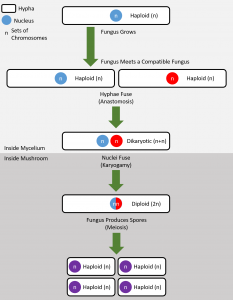
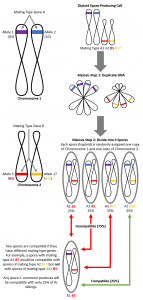
![#021: Pleurotus ostreatus, The Oyster Mushroom [Archived]](https://www.fungusfactfriday.com/wp-content/themes/hueman/assets/front/img/thumb-medium-empty.png)
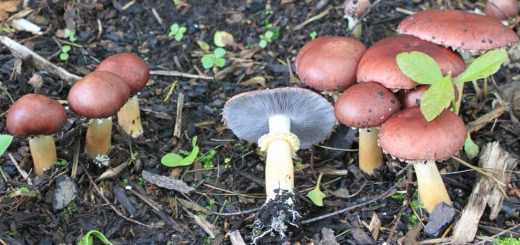





![#011: Characteristics of Kingdom Fungi [Archived]](https://www.fungusfactfriday.com/wp-content/themes/hueman/assets/front/img/thumb-small-empty.png)

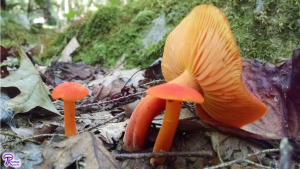
1 Response
[…] underside. This species exists globally, on every continent except Antarctica. They also have 28,000 different sexes! You can eat them too. Although it takes quite a few of them to make a meal. They can be a little […]